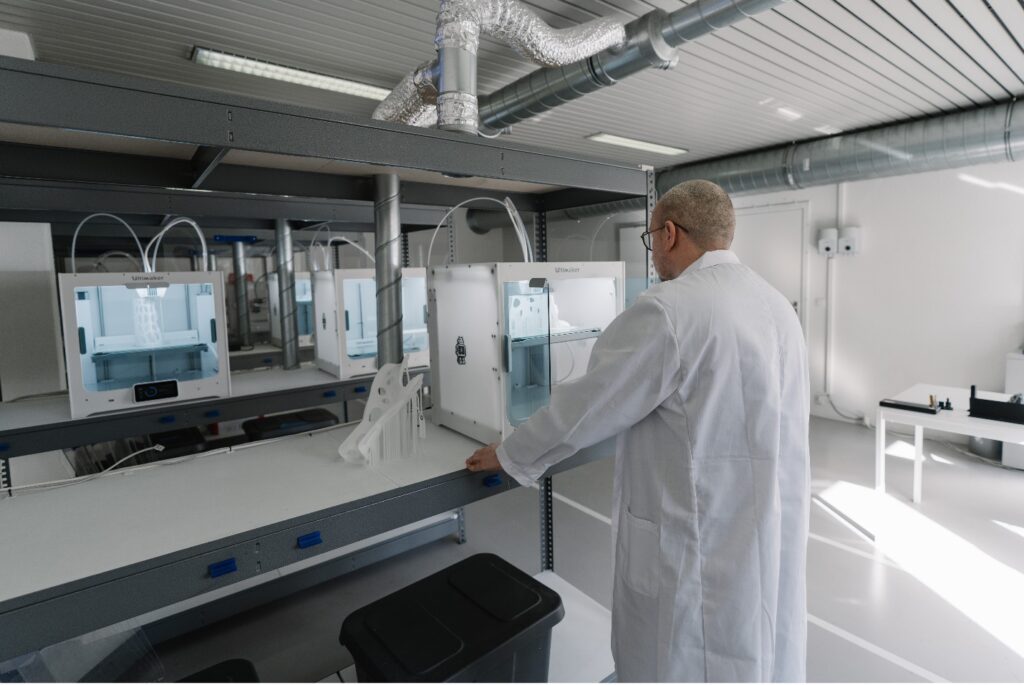How closely have you been watching the medical industry? Physicians have adopted 3D printing for healthcare to develop tailored treatments and solutions while minimizing costs and environmental impacts. Learn more to stay ahead of the curve.
In recent years, 3D printing has emerged as a transformative technology with the potential to revolutionize various industries, and healthcare is no exception. Integrating 3D printing in medicine has paved the way for innovative solutions, ranging from patient-specific implants to bioprinting tissues and organs.
This groundbreaking technology is reshaping the healthcare landscape by offering personalized treatments, improving surgical outcomes, and advancing the field of regenerative medicine. In this comprehensive exploration, we will delve into the multifaceted impact of 3D printing on healthcare, highlighting key advancements, challenges, and the promising future it holds.
Table of Contents
Patient-Specific Implants with 3D Printing in Healthcare
Surgical Planning and Education
3D Printing in Healthcare Education
Prosthetics and Assistive Devices
Lower Prosthetic Production Costs with 3D Printing Technologies
Improving Accessibility with 3D Printing in Healthcare
Bioprinting Tissues and Organs
Regulatory and Ethical Considerations of 3D Printing in Healthcare
3D Printing in Healthcare: Future Considerations and Challenges
Patient-Specific Implants with 3D Printing in Healthcare
One of the most significant contributions of 3D printing to medicine is in the realm of orthopedics. Patients with complex bone injuries or degenerative diseases often require customized implants to restore function and alleviate pain. Traditional manufacturing methods struggle to meet the precise requirements of these cases, leading to suboptimal outcomes.
3D printing in healthcare enables the creation of implants tailored to the patient’s unique anatomy. Using patient-specific imaging data, such as CT scans, surgeons can design implants that fit precisely, reducing the risk of complications and improving patient comfort. They can also use various materials, including biocompatible metals and polymers. Surgeons can select materials that suit the patient’s needs, ensuring longevity and compatibility.
Patients often experience faster recovery times and reduced post-operative pain with personalized implants. This benefit improves the quality of life and reduces the burden on healthcare systems, from surgical to dental and everything in between.

We offer fast, high-quality, tailored PROTOTYPING solutions for leading companies in a wide range of industries.
superior Rapid PROTOTYPING
3D Printed Dental Implants
Dental medicine has also benefited immensely from 3D printing technology. Dental implants, crowns, and bridges use 3D printing techniques to offer several advantages over traditional methods. These innovative digital fabrication methods create highly accurate dental prosthetics that resemble natural teeth in shape and color.
Many cutting-edge dentists use rapid prototyping to test implants in a patient’s mouth, leading to more efficient treatment planning and reduced chair time during routine appointments. Beyond implants, 3D printing enables partial and complete denture fabrication, creating affordable and customized solutions for patients with missing teeth.
Did You Know: 3D printing isn’t only for human healthcare. It’s being used to design and produce prosthetics for animals, from dogs to turtles, enhancing their quality of life.
Surgical Planning and Education
3D printing in healthcare plays a pivotal role in surgical planning and education. Surgeons can create detailed anatomical models of a patient’s condition, facilitating preoperative planning and enhancing surgical precision. Three-dimensional models offer a tangible representation of complex anatomical structures, helping surgeons better understand the patient’s condition and plan the surgical approach.
Meanwhile, modern medical institutions and surgical training programs use 3D-printed models for hands-on training, allowing aspiring surgeons to practice procedures in a risk-free environment. Preoperative models enable surgeons to anticipate potential complications and develop mitigation strategies, ultimately improving patient safety and outcomes.
3D Printing in Healthcare Education
In addition to surgical training, 3D printing enhances medical education by providing medical students and professionals with tangible learning tools. For instance, detailed 3D-printed anatomical models are used in medical schools to teach anatomy more effectively, promoting a deeper understanding of the human body.
Students can study pathological conditions using 3D-printed disease models to improve diagnostic skills and medical knowledge. Also, physicians can use 3D-printed models to explain medical conditions or treatment plans to patients, enhancing communication and patient engagement.
Prosthetics and Assistive Devices
The integration of 3D printing in medicine has also transformed the field of prosthetics and assistive devices. It has opened the door to customized prosthetics tailored to patients’ unique needs and preferences. Here’s how:
- Personalization: Prosthetics can match the patient’s specific anatomy, providing a comfortable fit and improved functionality.
- Affordability: Traditional prosthetic manufacturing can be costly and time-consuming. 3D printing significantly reduces production costs, making prosthetics more accessible.
- Rapid Iteration: As patients’ needs change or improve, 3D-printed prosthetics can be easily modified and reprinted, ensuring ongoing comfort and function.
This level of personalization enhances comfort and functionality, addressing each user’s unique challenges. Whether it’s a prosthetic hand, leg, or assistive device like a wheelchair, 3D printing ensures a snug fit and optimal performance.
Lower Prosthetic Production Costs with 3D Printing Technologies
Traditional prosthetic limbs can be prohibitively expensive, making them inaccessible to many. 3D printing significantly lowers healthcare costs, democratizing access to these life-enhancing devices. This affordability is especially crucial in regions with limited healthcare resources.
3D printing allows for quick and cost-effective prototyping and iteration. Prosthetists can adjust based on user feedback, ensuring a perfect fit and functionality. This iterative process reduces waiting times for patients and enhances overall satisfaction.
The flexibility of rapid prototyping and 3D printing in healthcare creates complex, lightweight structures that were previously impossible to manufacture using traditional methods. This results in prosthetic limbs that are functional and aesthetically pleasing.
Improving Accessibility with 3D Printing in Healthcare
3D printing can potentially address the accessibility to assistive devices, particularly in underserved regions and developing countries. Local production means communities can produce essential assistive devices on-site, reducing the need for expensive imports.
Additive manufacturing and other digital fabrication techniques also support humanitarian initiatives. Several organizations use 3D printing to provide prosthetic limbs and other assistive devices to people in need, improving their quality of life. Innovative work from the 3D Medical Applications Center in Bethesda is a primary example.
Bioprinting Tissues and Organs
The most revolutionary application of 3D printing in medicine is bioprinting, which promises to create functional human tissues and organs. Bioprinting tissues and organs is a groundbreaking field at the intersection of biology, engineering, and medicine, offering a glimmer of hope for patients in need of life-saving transplants.
This innovative technology utilizes 3D printing techniques to create complex biological structures using living cells as “ink.” The potential applications are immense and transformative. Rapid bioprinting has the potential to address the organ shortage crisis. Meanwhile, thousands of individuals worldwide are on waiting lists for organ transplants; many die before receiving the necessary treatment.
Bioprinting can revolutionize organ transplantation by enabling the fabrication of patient-specific, functional organs, eliminating the need for donors, and reducing the risk of rejection. Moreover, bioprinting isn’t limited to organs alone. It can also produce tissues, like skin, cartilage, and blood vessels, for various medical purposes. These tissues help streamline drug testing, disease modeling, and cosmetic applications.
Significant challenges remain to overcome, such as ensuring the long-term viability of bioprinter organs and obtaining regulatory approvals. Nonetheless, the progress made in bioprinting tissues and organs holds immense promise for 3D printing in healthcare, offering hope for a future where waiting lists for transplants are a thing of the past.
Did You Know: Scientists have successfully bioprinted small-scale functional human organs like mini livers and kidneys. Although not yet suitable for transplantation, they serve as valuable tools for drug testing and research.
Principles of Bioprinting
Bioprinting involves using specialized 3D printers and bioinks consisting of living cells to create biological structures layer by layer. These are typically composed of living cells, biomaterials, and growth factors. Doctors carefully formulate them to support cell growth and tissue maturation.
Like traditional 3D printing, bioprinters deposit successive layers of bio-ink, allowing for the precise construction of complex tissue structures. However, bioprinting still faces several challenges, including ensuring cell viability, vascularization, and tissue functionality.
Bioprinting Applications
Bioprinting holds immense potential for a wide range of medical applications. Researchers are working on bioprinting techniques to create functional tissues like skin, cartilage, and bone for transplantation and wound healing.
The ultimate goal of bioprinting is to create functional organs for transplantation. Although this is still in the experimental stage, it promises to address the organ shortage crisis. Bioprinter tissues are also beneficial for studying diseases in vitro, allowing researchers to develop and test new drugs and therapies.
Did You Know: The U.S. Food and Drug Administration (FDA) approved the first-ever 3D-printed pill, Spritam, for epilepsy treatment in 2015. This 3D printing method allows for a more soluble pill, enabling faster relief.
Regulatory and Ethical Considerations of 3D Printing in Healthcare
The rapid adoption of 3D printing in medicine has raised important regulatory and ethical questions. Let’s explore them next:
Regulatory Challenges
- Quality Control: Ensuring the safety and quality of 3D-printed medical devices and implants is a significant challenge. Regulatory agencies must establish guidelines and standards for these products.
- Intellectual Property: The digital nature of 3D printing raises concerns about intellectual property rights, especially regarding medical devices and pharmaceuticals.
- Liability: Determining liability in cases of 3D-printed medical devices or implants that fail or cause harm can be complex, requiring adapting legal frameworks.
Ethical Considerations
- Informed Consent: Patients must be informed about using 3D printing in their treatment and provide informed consent.
- Privacy: The storage and sharing of patient data, especially in creating patient-specific implants or tissues, raises privacy concerns that medical professionals must address.
- Equity: Ensuring equitable access to 3D-printed medical solutions is essential, as the technology could exacerbate existing healthcare disparities if not adequately managed.
3D Printing in Healthcare: Future Considerations and Challenges
The future of 3D printing in medicine is promising, but it also faces several challenges and uncertainties. For instance, developing functional blood vessels within bioprinter tissues and organs remains a significant challenge, as vascularization is crucial for tissue viability.
Vascularization, the process of creating a network of blood vessels to supply nutrients and oxygen to cells, is crucial for the viability of any tissue or organ. Without adequate vascularization, these structures cannot survive and function properly within the human body. Researchers are actively working on techniques to address this challenge, experimenting with bio-ink formulations and innovative printing methods that can facilitate the creation of intricate vascular networks.
While progress is evident in more superficial tissues like skin and cartilage, the road to bioprinting complex organs such as the heart or liver is fraught with unique difficulties. These organs have intricate structures and multiple cell types that must be precisely arranged to ensure functionality. Achieving this level of complexity in bioprinting requires further research and development, focusing on refining printing techniques and enhancing the biological materials used.
As 3D printing in healthcare progresses towards the possibility of creating functional organs for transplantation, the approval process becomes a lengthy and complicated journey. Regulatory bodies, healthcare institutions, and the public must collaborate closely to establish stringent standards for safety, efficacy, and ethical considerations.
Patient safety, ethical concerns, and the long-term effects of bioprinter organs on recipients must be thoroughly studied and addressed before these groundbreaking technologies become part of mainstream medical practice.
Did You Know: Over 95% of the hearing aids used today are manufactured using 3D printing technology, transforming and speeding up the customization process.
Conclusion
3D printing has revolutionized the healthcare industry, offering patient-specific implants, enhancing surgical planning, improving prosthetics, and pushing the boundaries of regenerative medicine through bioprinting. These advancements have the potential to significantly improve patient outcomes, reduce healthcare costs, and address critical medical challenges. However, they also bring about regulatory, ethical, and technical considerations that matter greatly.
As bioprinting advances and becomes more integrated into clinical practice, it promises to address the organ shortage crisis, potentially saving countless lives. However, the journey from experimental bioprinter tissues to functional organs for transplantation is fraught with challenges and uncertainties.
In the coming years, 3D printing in medicine will continue to evolve, with ongoing research, technological advancements, and regulatory developments shaping its trajectory. The key will be to balance innovation and safety, ensuring that this transformative technology benefits patients and the healthcare industry. The new layers of invention are shaping the future of medicine that 3D printing has brought, and its full potential is yet to be realized.
 About the Author
About the Author
James Murphy is the founder and CEO of HLH Rapid – a hybrid CNC machine shop fusing Western service and quality with Eurasian industry influences for over 14 years. His advanced enterprise uncovers cost-effective rapid injection molding techniques to remain unmatched by industry competitors. Murphy’s full-service fabrication and manufacturing methods span six dedicated zones, from 3D printing and vacuum casting to sheet metal prototyping and project management. His expertise also includes high-efficiency machining within strict yet volatile markets.
Murphy earned an MBA after becoming inspired by his father’s hands-on craftsmanship. As a budding entrepreneur, he taught English and studied Chinese to pursue pioneering objectives. His groundbreaking approach helps build the future by providing well-rounded manufacturing services to innovative Western businesses. When he’s not offering upscale RP and CNC, James enjoys art-house movies, Thai boxing, and spending time with his growing family.
Visit HLHRapid.com for an instant quote on rapid prototyping services.


